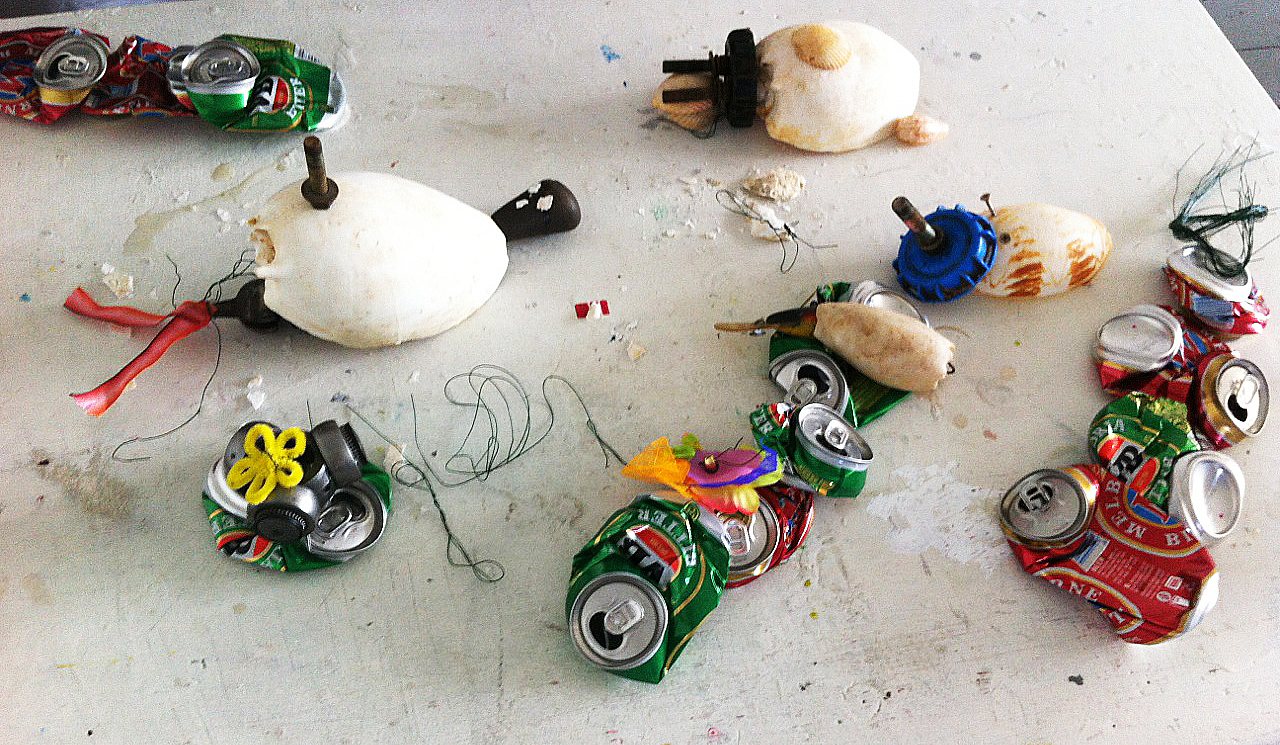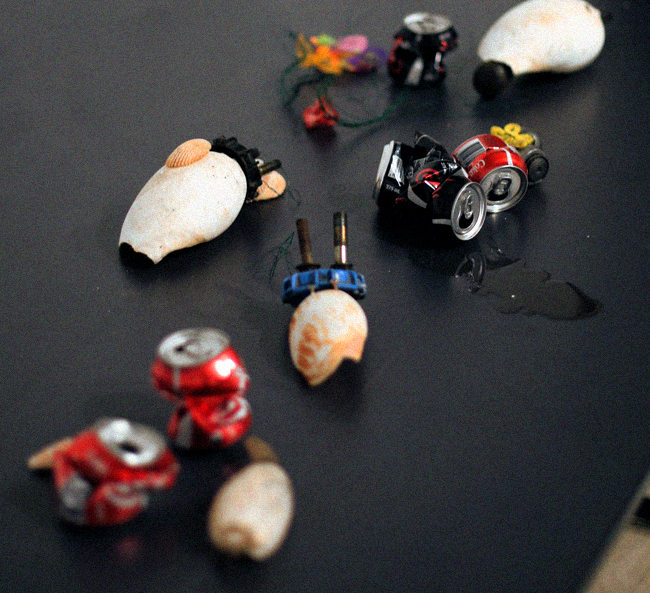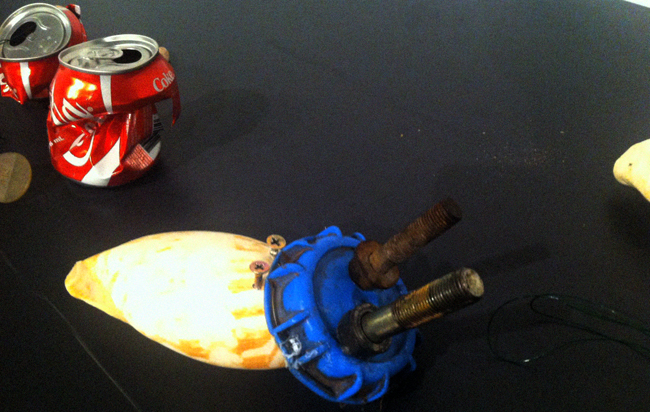— Windjarrameru, The Stealing C*nts

Like their previous film, the Karrabing Film Collective’s second work, Windjarrameru (The Stealing C*nt$), is a piece of improvisational realism. The basic plot is set in the scrub near Darwin, Australia and is easy enough to summarize. A group of four indigenous young men, played by members of the collective, are holed up in a chemically compromised mangrove swamp having been falsely accused of stealing two cartons of beer, while at the edge of the standoff miners are ransacking the country. Kelvin Bigfoot and Gavin Bianamu proposed the basic idea—they wanted to tell a story about finding two cartons of beer in the bush and running away from cops who were trying to arrest them.
Other Karrabing members added layers of characters: two corrupt miners and two local men illicitly sampling a possible iron ore deposit that sat dangerously close to a sacred site; a community land-ranger group secretly tracking their furtive activities; community kids who, arriving at the scene of the standoff, immediately pocket a police siren for fun; community parents worried that if their sons don’t emerge from the swamp they’ll be harmed by the chemical spill and if they do emerge they will be locked away in a Darwin jail; nyudj (ancestral spirits) inhabiting the same landscape and playing tricks on the young men; and a well-intentioned but befuddled white woman from aboriginal legal aid trying to understand what the possible theft of two cartons of beer might have to do with potential illegal mining in the area.
As she puts it, “Why would miners leave beer in the middle of the bush to trap local young men?” How could beer be part of an elaborate plan to erode indigenous sovereignty of place—is the beer a scheme to create a swamp of a different type: a cesspool of substance abuse in which indigenous people are trapped? Even those of us making the film do not have a definitive answer; everyone answers slightly differently when asked, “Aba windjarrameru (Who are the stealing cunts)?”
It took no written script for the Karrabing actors to quickly come up with the reasons why the young men would be thrilled to find beer abandoned in the bush; why the two middlemen miners would take the bribe; why local indigenous men would consider blasting near a sacred site; why the community land rangers would need to resort to a covert spy mission. The young men want to drown out the monotony of their lives; the miners want the good life as exemplified by the purchase of flash boats and trucks; the land rangers cannot rely on the local land councils because their funding is dependent on mining; and the local men are up to their noses in the small fines that turn into heavy debts—a state of affairs now endemic to the racialized financing of cities in late liberalism.
In this regard, remote Northern Australia is no different from the suburbs of Middle America. For instance, an ArchCity Defenders report found that in the year leading up to the 2014 shootings in Ferguson, Missouri, the municipalities of Ferguson and Florissant made a combined net profit of $3.5 million off their municipal courts, most of which came from fines paid out for nonviolent driving offenses. And African-Americans were twice as likely to be stopped and searched as whites and twice as likely to be arrested or fined, even though the search of African-Americans resulted in the discovery of illegal substances only 21.7 percent of the time while the rate for whites was 34 percent of the time. Often on welfare or working at the extreme lower edge of the wage scale, these men and women often face a choice: to put themselves on a payment plan with interest rates that result in ever-increasing indebtedness, or not to pay and risk imprisonment.
Northern Territory jails in Australia are hemorrhaging indigenous men and women caught in a similar loop. In Windjarrameru, when the corrupt miners ask the two local men how much of their fines they have left to pay, the amounts of “1300.32 cents” and “500” slip off their lips; real numbers for the real people whose annual income is around $12,000 in Australian dollars. And just as this exchange finishes, the land rangers arrive at the swamp in a locomotive fine factory—a factually unregistered jerry-rigged truck. The fictional police on scene just shake their heads.
Corruption is like this. Not ultimately or originally about abstract values, bills stuffed into an unmarked envelope passed from hand to hand, but about the materially figurating effects of public secrets.1 Michael Taussig, Public Secrecy and the Labor of the Negative (Stanford: Stanford University Press, 1999).One knows something is up but not what. One can’t specify what quasi materialities and quasi events are transforming the small inlets into a social milieu and diverting the architectures of existence elsewhere.
Corruption has no top and no bottom because it doesn’t have that kind of shape. It’s not a shape. Corruption is a corrosion that becomes contagious. The contagion alters the embagination of entities producing pure waste and purified value—transforming complex swamp ecologies into undiluted shit and unadulterated H2O; the effluents are left behind for the inhabitants, everything else piped to the gated communities of affluence.
When we say that corruption is internal to predatory capital, or that corruption is capitalism’s proper name, we cannot be content to say, “Capital is dead labor, which, vampire-like, lives only by sucking living labor, and lives the more, the more labor it sucks.”2 Karl Marx, Capital, vol. 1, unabridged (New York: International Publishers, 1967), 224.The pipes that push into the Earth’s viscera to shatter an existing shale formation to fill another pipe to fuel vast refrigeration apparatuses set to cool “the cloud” that’s heating the Earth as information capital claims a new ground: capitalism makes no distinction between life and nonlife.
In other words, corruption is irrevocably a geontology—the matter that forms as entities struggle to maintain or enhance their milieu in late liberalism. Corruption is the signal that various forms and arrangements of existents are losing their powers of existence. Corruption is the meandering path of Kynde in Piers Plowman, one of the first literary sources of the term corruption itself. “Kynde come after with many kene sores, As pokkes and pestilences and moche poeple shente; So kynde þorw corupciouns kulled ful manye.”3 Hoyt N. Duggan, Ralph Hanna, and Thorlac Turville-Petre, eds., Piers Plowman, Oxford Manuscript, 88-89v. See →The need to think through how corupciouns kulled ful manye (corruption kills many) centers the narrative of Windjarrameru.
When one of the young men, Reggie Jorrock, finds an old bottle of flagon lodged in the mangrove mud, others try to tell him it is pelkuding (rotten). Glowing bright green rather than deep red, the flagon is clearly poisonous, poisoned. But between the poisoned and the poisonous sits the undecidable question of corruption. Why, always why—and who? Did the chemical spill leak into an otherwise lucky find, or did the young men’s ancestors leave it as a sign—or lure—for what is happening all around them?

Windjarrameru is hardly the first film to portray corruption as a matter of the differential distribution of pelkuding worlds. Look at Hubert Sauper’s Darwin’s Nightmare (2004), in which the indigenous peoples of Lake Victoria are left to survive on the rotted carcasses of the invasive perch fish discarded by the food-processing factories, which are slowly corroding the lake habitat and the humans clinging to its edges. Or take Matteo Garrone’s Gomorrah (2008), in which toxic waste, chromium, and asbestos are illegally buried in old quarries and tilled fields in the slums of Campania so that a beautiful basket of peaches, proffered to the profiteers as thanks for their investment in the community, is quickly discarded because teaming within it are poisons that have sprouted from the groundwater. These films can be seamlessly inserted into the current scandal of chemically ravaged Martinique.
The Allied Signal Company, located in Hopewell, Virginia, began producing chlordecone (also known as kepone) in the 1950s as a pesticide. After an environmental spill and public scandal in the 1970s, chlordecone was banned in the US. But powerful planter groups on Martinique and Guadeloupe (principally local whites or békés) imported stockpiles of the pesticide with the approval of France, despite the fact that France had banned its use within its own continental borders. By the time France banned its use throughout its jurisdiction, the human and environmental damage was catastrophic for the existing arrangements of things. Disturbing new human bodies emerged, as well as foods that looked the same but were not. Even the winds became worrisome, as the involuntary nature and necessity of breathing became a potential threat to existence.4Vanessa Agard-Jones, “Spray,” in Somatosphere, (May 27, 2014). See →
Perhaps the central purpose of Karrabing’s films is to discover what we never knew we knew by hearing what we say in moments of improvisation. We suddenly see what we have been saying—what we have been sensing. But knowing something is not equivalent to solving something if by solving we seek an intelligible action. For instance, here we are, day seven, shooting a scene inside the mangrove. The four young men are monitoring the police lest they try to raid their hideout. I am standing there with Daryl Lane, Kelvin Bigfoot, Reggie Jorrock, Marcus Jorrock, Gavin Bianamu, and our small film crew.
I directed Reggie to lean through a tangle of roots and look worried—as if the police might, at any minute, raid their hideout. I then suggest to Kelvin that he reassure Reggie. Kelvin asked me, “What should I say?” I reply, “I don’t know. What would you say in this kind of situation?” Kelvin turned to his uncle, Daryl, and asked, “Uncle?” And Daryl answered the implicit question, “You. You. What would you say?” After a beat, Kelvin turned to Reggie and said, “Don’t worry, RJ. They wont come in here. We’re safe, too much radiation here; we’re safe.”

And when Reggie’s brother, Marcos, says in response, “I don’t want to die here!” Kelvin replies, “Hey, our grandfathers died here first, we can die here after.”
On set and then watching the rushes and the edits as they emerged over the course of the next eight months, various Karrabing members paused, laughed, nodded, guffawed, but most agreed that what Kelvin said was true even as this truth has no place in sense. In other words, his statement was diagnostic if not prognostic—or perhaps the prognosis is a form of survivance in which survival does not quite fit into the picture.
Indigenous sovereignty over space fully reemerges in the space of utter state abandonment and total capital despoilment. The men’s grandparents did die there first during the grinding contagion of settler colonialism, then reemerged as nyudj. Their gifts are within and emerge through the materialities of the place, and are not abstracted from or abstractions of it. Time contracts and moves through this material. Present action is constantly circulated through and assessed by black and white state representations and public fantasies about “traditional” verses modern practices even as ancestral creatures, and their sacred areas (dreamings, durlg; therrawen), are being decomposed for their mineral content and recomposed as composites of crushed beer cans, plastics, wire, and chemical effluents.
Kelvin tells Reggie they are sovereign over this place because this place is becoming something that expels those who have caused it to be in this radioactive form. This, everyone says, is true. But no one knows what results from this truth—that indigenous sovereignty safely emerges in the corrupted and corroded areas of late liberal capital and governance—that sovereignty now thrives where Europeans have come, destroyed, and are fearful of returning but to which the Karrabing continue to hold on. No one can foresee what forms of existence can be held onto, which ones reshaped in this milieu—themselves included—in this small pocket of corruption. But we play with the possibilities.
×


